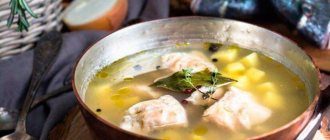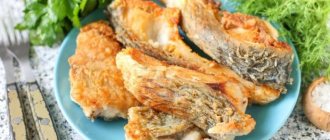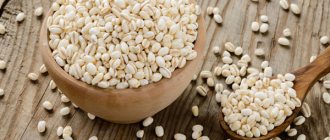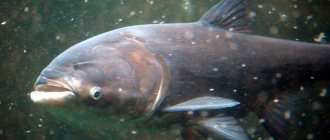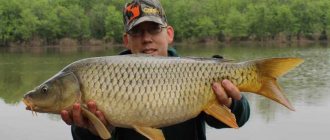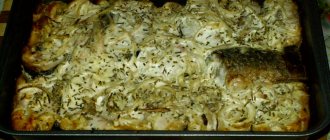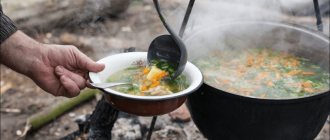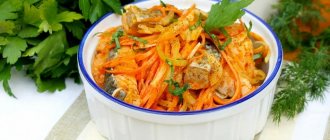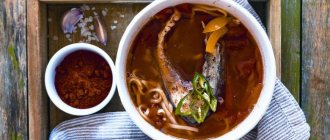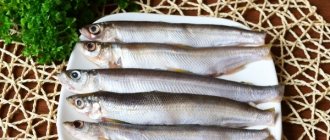Live trout
Trout is a trophy specimen that every fisherman dreams of getting. The fish is very beautiful and capricious. It belongs to the salmon family.
On the body of the trout you can find multi-colored specks that distinguish it from other members of the family. The fish looks very massive and seems tightly knit, but this is only at first glance.
Recently, more and more private fish farms have begun to pay attention to this individual. They began to breed it in artificial reservoirs. The capricious fish takes a long time to get used to artificial conditions, but with proper care it can reach large sizes and gain the required body weight.
When looking at a trout, its body may seem disproportionate. The body is slightly compressed, but the scales are located evenly. The muzzle is slightly blunt and seems very small. The predator has sharp and massive teeth. They are located in the bottom row. There are only 4 teeth in the upper jaw, but they are irregular.
Trout is an expensive fish. It is not available in all stores. But, recently, it has become fashionable to catch it in artificial ponds. The price per kilogram is no more than $10 (depending on the type). Live trout for stocking your pond can be viewed on the page - Live trout with prices.
Delicious and simple trout dishes
Seafood is a delicacy food with delicately flavored meat. It literally melts in your mouth. Fish is often grilled, baked over coals, in the oven, in a slow cooker, fried, or salted. In the Caucasus, it is stewed with wine sauce, fruits, vegetables and spices. Fish marinated in vinegar turns blue. In Japan, trout is smoked, salted and canned.
Trout baked in the oven
This healthy, tasty dish is easy to prepare.
Grocery list:
- trout – 1 carcass;
- onion – 2 heads;
- fennel – 25 g;
- potatoes – 4 pcs.;
- tomato – 3 pcs.;
- lemon – 1 pc.;
- garlic – 2 cloves;
- salt;
- seasonings
Recommended reading: Benefits of tomatoes for the body
How to cook:
- The fish is cleaned and removed from the entrails and black film.
- Pour over lemon juice and rub with spices.
- Fry onions with fennel.
- The carcass is stuffed with the mixture and poured with oil.
- Place tomatoes, potatoes on a greased baking sheet, and trout on top.
- Place in the oven to bake for 40 minutes at 200°C.
We recommend reading: Potatoes: beneficial properties and contraindications
Readiness is checked by the formation of a golden crust. As soon as it appears, the dish is ready.
Trout in foil on coals
Components:
- fish fillet – 500 gr.;
- lemon – 1 pc.;
- dill - 1 bunch;
- vegetable oil – 4 tbsp. l.;
- soy sauce – 3 tbsp. l.;
- sugar – 1 tsp;
- red pepper - a pinch.
Cooking method:
- The fish is washed, dried and cut into small pieces.
- The marinade is prepared as follows: mix lemon juice, oil, soy sauce, sugar and pepper, add finely chopped dill.
- Soak the steaks in brine and leave for 50 minutes.
- Then the pieces are laid out on foil, wrapped and sent to the wire rack.
- Bake the fish until a golden crust forms.
Recommended reading: Benefits of boiled beets for the body
Trout varieties
Types of trout:
- Rainbow. Scientists classify this type of trout as freshwater. Her body is long, and in weight she is slightly inferior to her stream sister - only 5-7 kilograms. The scales are small. It also differs from its counterparts in color - there is a bright pink stripe on the abdomen.
- Ruchevaya. Trout of this species can grow up to 50 centimeters and reach 13 kilograms. This is probably the largest species of the family. It is also distinguished by its body structure. It is elongated and covered with small scales. The fins are large. There are a lot of teeth, they are very small, but quite sharp. The head is strongly flattened. Color: the back is reddish-brown, the sides and belly are silvery. Some individuals have small black spots.
- Ozernaya. The predator lives no more than 13 years and during this time it can grow up to 55 centimeters in length and gain up to 2 kilograms. In artificial ponds, fish can gain up to 8 kilograms. The species is not very different from the brook in color.
Appearance of trout
The overwhelming majority of trout representatives are small fish, with a body length of 25-30 cm and a weight of 200-500 grams.
The length of brook trout is about 30 cm
These parameters are valid mainly for brook (river) and rainbow trout, which are grown in ponds, cages and pools. Some specimens can grow much larger and gain weight up to 1 or 2 kilograms, but such fish can only be found in natural habitats for trout, that is, in the wild.
Different types of trout are colored differently, depending on the conditions in which they grew up. Individuals with a dark olive back with a greenish tint have a classic coloration. On the light sides with transverse stripes, small spots of dark red or black color are clearly visible (in some fish they are also surrounded by a light border). The abdomen is white with a hint of gray (sometimes copper-colored).

A variety of trout: they have differences in appearance due to the characteristics of their habitat
If we look at it as a whole, we can determine that one trout has predominant dark tones, while the other has predominant light tones. This depends on the food that the fish eats, the transparency and composition of the water of the reservoir in which it lives, the time of year and, in some cases, the color of the bottom. For example, in calcareous water, light silver specimens predominate, and if the bottom is covered with silt or is peaty, the color of the trout will be dark. If there is abundant food that is easily accessible to the fish, spots on its sides may be absent, and when the reservoir changes, they may disappear and appear along with the stripes.
Habitat
Based on their habitat, sea trout and river trout can be distinguished. They differ in the size and color of the meat.
The sea predator is much larger, and its meat is dark red. It is found mainly off the coast of North America in the Pacific Ocean.
The river specimen prefers to live in mountain rivers, in clean and cool water. That is why this fish can be found in Norway and other mountainous countries. It is also found in lakes.
It lives mainly at the mouths of rivers and closer to rapids. You can also see it near bridges. In mountain rivers it settles near pools, but quickly leaves its habitat.
For this fish it is important that the bottom is rocky. If the fish begins to sense danger, it hides behind large rocks and snags.
In regions with hot summers, it prefers to migrate to areas with cold springs and springs.
Trout steaks in the oven with mustard and honey
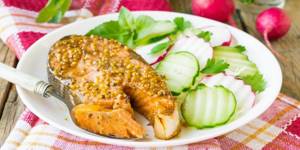
Photo: silina.darina.gmail.com / Depositphotos
Ingredients
- 2 tablespoons mustard;
- 1 tablespoon liquid honey;
- 2 trout steaks;
- salt - to taste;
- pepper - to taste;
- 1 tablespoon lemon juice;
- 1 teaspoon vegetable oil.
Preparation
Mix mustard with honey. Rub the fish with salt and pepper, pour in lemon juice and brush with honey-mustard sauce.
Grease the foil with oil and wrap the trout in it. Transfer the fish to a baking dish. Cook for approximately 15-20 minutes at 175°C. 5 minutes before cooking, open the foil.
Trout breeding
Trout, during spawning, behaves very interestingly, like all representatives of the salmon family. Rarely, but during this period, fish can be seen near the shore or on the surface of the reservoir. It rises briefly and behaves very actively: it moves quickly through the water and splashes heavily.
Trout conduct mating games on the surface of the reservoir. After their completion, the young animals return to their usual life and sink to the bottom or return to their native reservoir. The other part will remain here until the period of spawning.
Trout are not prolific. A female can be considered mature only in the third year of life. The larvae appear only in early spring. At first, they are completely motionless and feed on the food that is in the bag. Only after 40 days do they begin to move a little, and then leave their shelter.
The trout immediately shows their predatory nature and immediately begins to feed on small insect larvae. In the first 2-3 months, the larvae grow very quickly, then their growth slows down a little. In a year, the fish grows up to 15 centimeters. The growth rate is affected by the water in the reservoir and its size. For example, in a large lake they have more food than in a small body of water. You won’t find huge trout in small rivers; they grow no more than 20 centimeters in length.
White or red
Trout is considered a general name for various fish that have different colors of meat, which depend on the habitat and type of food.
It lives in various bodies of water and changes its habitat depending on the season and other factors. How do you prefer to cook trout?
- Bake 78%, 1959 votes
1959 votes 78%1959 votes - 78% of all votes
- Grilled 11%, 289 votes
289 votes 11%
289 votes - 11% of all votes
- Fry 5%, 135 votes
135 votes 5%
135 votes - 5% of all votes
- For a couple 3%, 84 votes
84 votes 3%
84 votes - 3% of all votes
- Extinguish 2%, 57 votes
57 votes 2%
57 votes - 2% of all votes
Total votes: 2524
15.12.2019
×
You or from your IP have already voted. In addition to its habitat, trout is divided into 3 subspecies:
- the loach subspecies includes big-headed, lake, American and other varieties;
- the salmon subspecies includes the following varieties: sea golden, rainbow, Caucasian and others;
- The species of noble salmon consists of Sevan, marble, flathead and other varieties.
The meat of sea trout is usually red, like most salmon. However, the fish sold in stores is grown artificially in fish farms. In most cases, it is a white-fleshed trout that sometimes has a pink tint.
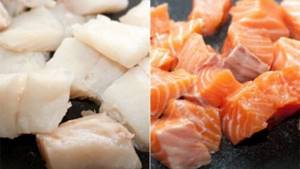
Growing trout in artificial reservoirs
Breeding trout is not that easy. And, if you paid attention to this particular species, then be prepared for difficulties. But all your efforts will definitely pay off when your young animals grow up.
Trout needs a large body of water, and if you don’t have one on your property, then choose something else. Water quality also affects the breeding of this species. In dirty, muddy water, without enough oxygen, the trout will simply die.
In seawater, trout grow very quickly and reach their maximum size in a short period. But in fresh water, the fish will not be able to develop normally and over a certain period will only grow to medium size.
Remember, in the reservoir where the trout will live, the water must be clean and cold. Never add chlorine to water, it has a detrimental effect on the health of individuals and leads to death.
Experts advise breeding trout in cages and feeding them from a special frame that is attached to the shore. Cages can be placed in any body of water, both in a lake and in a river. No more than 1000 individuals are released into the reservoir.
Individuals do not reproduce in artificial ponds. To do this, a special broodstock is released into the reservoir, which lays eggs.
Trout prefers natural food. It is advisable to keep the fry separately so that the adults do not eat them.
You can purchase fry, fingerlings and adults in specialized stores or online stores. Trout is a fish that will always be in price. The cost of meat is growing every day and if you decide to breed this particular species, then be sure that you will not go wrong.
Useful properties and composition of trout
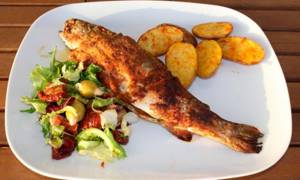
Since trout chooses exclusively clean water bodies for its habitat, its meat is valued at the highest level.
Live healthy! Rainbow trout.(04/21/2017)
Meat composition, vitamins and minerals
Trout meat contains the following beneficial components:
- Phosphorus.
- Yoda.
- Zinc.
- Polyunsaturated fatty acids Omega-3 and Omega-6.
- B vitamins, as well as other vitamins.
Calorie content of trout meat
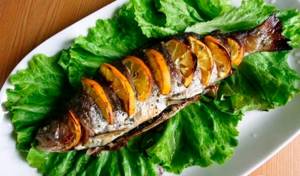
Trout meat is considered a low-calorie product, since 100 grams contains about 88 kcal . Therefore, nutritionists recommend consuming this fish as a dietary product. This is an ideal option for those who care about their figure.
From a medical point of view
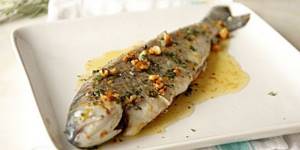
Regular consumption of trout helps fight serious illnesses such as cancer. In addition, the presence of useful components helps fight high blood pressure, improves the functioning of the central nervous system, relieves depressive mood, and improves memory.
Doctors recommend eating trout for people suffering from diabetes, as well as people with heart problems. Trout is probably the only fish that people prone to allergic reactions are allowed to eat.
Trout meat is an easily digestible product that does not burden the stomach.
From a cosmetics point of view
This product will be appreciated by those who watch their weight and figure. In addition, the presence of a whole bunch of useful components in trout meat will be reflected in improving the quality of teeth, hair and skin.
Interesting facts about the aquatic predator
- Trout cannot tolerate heat at all and at high temperatures simply falls into a coma. During this period, you can catch her with your bare hands, and she will not resist.
- Adult trout eat fry of their own species and not only in a hungry year.
- In salt water, trout grow much faster and gain the required weight in the shortest possible time.
- During the spawning period, trout are not afraid of anything at all. It can be seen next to boats and near the shore.
- Trout is a red meat fish that belongs to the salmon family.
- Trout can reach speeds of up to 18 kilometers per hour.
- Trout is not at all resistant to toxins. As soon as something poisonous appears in the water, these fish die instantly.
- Several large species and about 20 subspecies of salmon are united under the general name “Trout”.
- Trout, which lives in Japan in Lake Biwa, is considered to be an exotic species.
- Each species lives a specific life cycle. For example, sea trout, which lives in salt water, is considered the most durable. She is growing quickly and gaining a lot of body weight.
- In Norway, trout are first raised in the sea and only after they reach the required weight and grow to a certain size are they transferred to artificial ponds.
- Trout is very voracious. She can eat half her body weight in a day.
- Adults do not like to live in a flock. They guard their territory and hunt alone.
- Trout do not like the full moon. On a clear night, when the moon is shining brightly, she does not leave the shelter and does not hunt.
Is trout good for weight loss?
The benefits of seafood and its properties allow absolutely everyone to include the product on the menu. Trout helps you get rid of extra pounds. Fatty acids are significantly different from those found in meat. They do not cause harm, are perfectly absorbed and are not stored as fat.
Trout liver is also used to prepare delicious dishes. It is quickly digested. Many nutritionists recommend including healthy seafood and offal in your diet, since they have low calorie content and contain large quantities of important minerals.
Species and subspecies
- Rainbow trout Oncorhynchus mykiss
- Brook trout
- Genus Salmo
- Adriatic trout - Salmo obtusirostris
- Brook, lake trout or brown trout - Salmo trutta (several subspecies)
- Turkish flathead trout - Salmo platycephalus
- Marbled trout - Salmo trutta marmoratus
- Amudarya trout - Salmo trutta oxianus
- Summer trout - Salmo letnica
- Sevan trout – Salmo ischchan
- Genus Oncorhynchus
- Arizona trout - Oncorhynchus apache
- Biwa trout - Oncorhynchus masou rhodurus
- Clark's salmon - Oncorhynchus clarki
- Gil trout - Oncorhynchus gilae
- Golden trout - Oncorhynchus aguabonita
- Mykizha - Oncorhynchus mykiss
- Genus Salvelinus (Loaches)
- Salvelinus fontinalis timagamiensis
- American palia - Salvelinus fontinalis
- Bighead loach - Salvelinus confluentus
- Dolly Varden - Salvelinus malma
- Lake char (Salvelinus namaycush)
- Silver loach - Salvelinus fontinalis agassizi
Trout steaks in the oven with potatoes
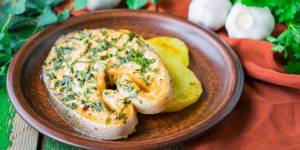
Photo: silina.darina.gmail.com / Depositphotos
Ingredients
- 450 g potatoes;
- 1 small lemon;
- 3–5 sprigs of parsley;
- 4 trout steaks;
- salt - to taste;
- pepper - to taste;
- 30 ml vegetable oil.
Preparation
Cut the potatoes and lemon into thin slices, chop the parsley. Take 4 sheets of foil and place potato pieces on each, and fish on top of them. Season with salt, pepper, oil, sprinkle with parsley and add lemon slices.
Wrap the foil. Place the trout on a baking sheet or in a mold and bake for 30 minutes at a temperature of 190–200 °C.
